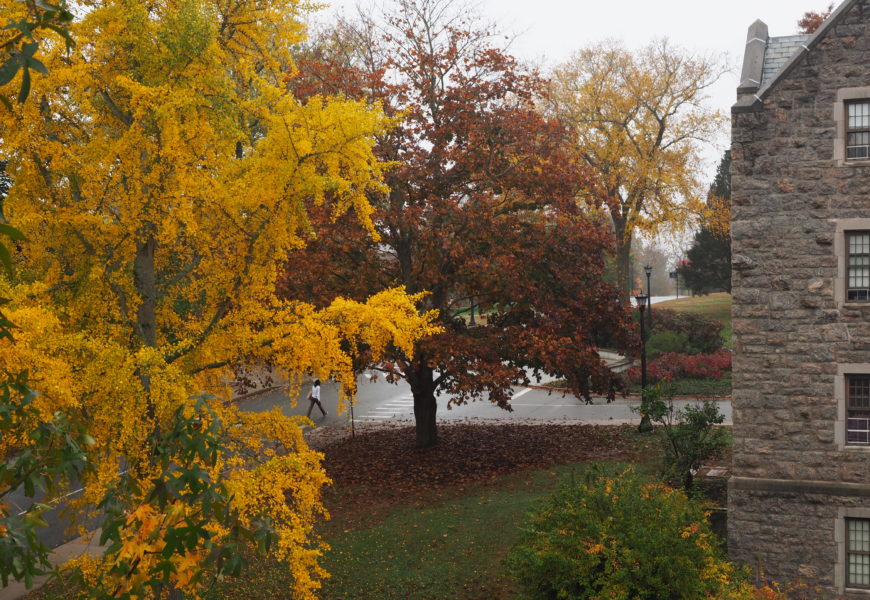Connecticut College, Fall 2019. Photo courtesy of Sophia Angele-Kuehn. This article was updated in January 2019 to fix factual inaccuracies.
Allow me to take you back to junior year of high school: we all remember our college counselors selling universities to us like we were high buyers at a luxury car dealership. When my jaw involuntarily dropped after hearing the price of Conn’s tuition, my counselor tried to clean up the mess by reassuring me that, “It’s a Little Ivy!” I’ll admit it — now I say it to friends and family back in California to make my beloved school sound more prestigious, since everyone thinks I go to UConn. But what does the term “Little Ivy” mean?
The more I dug around the Internet, the more confusing the moniker became. There is the Little Three, the Big Three, the Little Ivies, the Hidden Ivies, the NESCAC, the (actual) Ivy League — it seems as though every school created their own consortium as a means of being part of an esteemed group. However, these organizations do not span across the country; just about twenty schools on the east coast make them up in different combinations.
What is the point of these self-proclaimed groups? They add to the appeal of the school for prospective students. Due to the fact that most of these groups were created through word of mouth, the true meaning of these unions is questionable at best. They are used in college-help guides that should be named Enhancing Your Application to the Point Where It Might Be Lying In Order To Get You Into One of the Little Ivies. Other than that, I can’t say that the prestigious titles are recognizable to students who actually go to any one of these elite colleges and universities.
The Ivy League is the most well-known title, and the only one that is a certified organization. It consists of Harvard, Princeton, UPenn, Brown, Dartmouth, Cornell, Yale and Columbia. Contrary to popular belief, the Ivies are not grouped together because of their outrageously old legacies. These schools are associated with each other because they belong to the NCAA (National Collegiate Athletic Association) Division I athletic conference. It’s just a coincidence that each of them is very old, very well endowed and very hard to get into. Or at least that’s what they tell us.
Within the Ivy League is the Big Three, which consists of Harvard, Yale and Princeton. Similarly, there exists the Little Three, which includes Amherst, Wesleyan and Williams. These three small colleges are considered as socially and academically elite, as well as equally selective, as the Big Three.
The NESCAC is an acronym that every Conn student knows. This stands for the New England Small College Athletic Conference, which is a NCAA Division III athletic conference, consisting of eleven highly selective liberal arts schools: Amherst, Bates, Bowdoin, Colby, Connecticut College, Hamilton, Middlebury, Trinity, Tufts, Wesleyan and Williams. Most of these colleges are also members of the Hidden Ivies, which are institutions that rival the Ivy League with their academic competitiveness and admission selectivity.
According to most sources, the NESCAC schools are also considered Little Ivies. The “Little Ivies” is not an official group. The phrase seemingly refers to small, old, selective and competitive liberal arts schools in the Northeast.
This is where it gets a little confusing.
According to Harvardmomadvice.com, Colgate, Haverford, Swarthmore and Vassar are also a part of the Little Ivies. This would make sense, considering that they fit the aforementioned criteria. Some believe that the Little Ivies consist only of the Seven Sisters. The Seven Sisters are historically women’s colleges, consisting of Barnard, Bryn Mawr College, Mount Holyoke, Radcliffe, Smith, Vassar and Wellesley. Other sources say that the Little Ivies are the NESCACs without Connecticut College. (Conn was the latest addition in 1982.)
This is a complicated situation. Connecticut College is in some of these groups yet not in others; our school is simultaneously included and excluded. What’s the difference, though? Our acceptance rate hovers around thirty-two percent, which, even though it may not seem like it, is highly selective. We are ranked thirty-seventh out of at least 266 liberal arts colleges in the country. It is also predicted that we will make top twenty within the next ten years.
Our school outranks fantastic colleges like Dickinson, Pitzer, Skidmore and Reed. It is academically challenging. Our unique curriculum — including CELS, the certificate programs and the Honor Code — rival those of the best schools in the country. So whether this was your reach school or your safety school, whether it’s a Little Ivy or just a NESCAC, it doesn’t matter. Take pride in Connecticut College, fellow camels. •










“This stands for the New England Small College Athletic Conference, which is a NCAA Division III athletic conference, consisting of eleven highly selective liberal arts schools: Amherst, Bates, Bowdoin, Colby, Colgate, Conn, Hamilton, Haverford, Middlebury, Swarthmore, Trinity, Tufts, Vassar, Wesleyan and Williams.”
Colgate, Haverford, Swarthmore, and Vassar are not NESCAC schools. Check your facts.
11 Schools, one ‘Cac…one very confused College Voice author #factcheck